Major, long-duration X1.0 solar flare erupts from AR 2887, Earth-directed CME produced
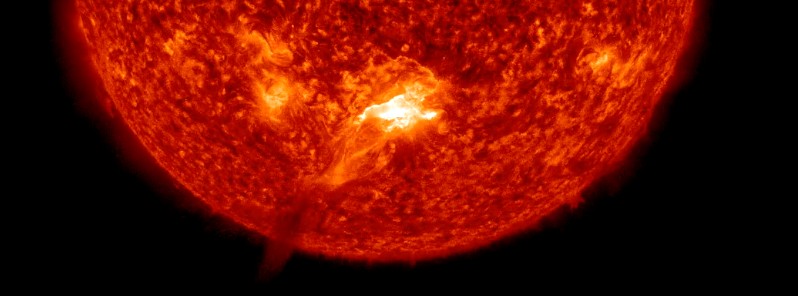
A major, long-duration solar flare measuring X1.0 at its peak erupted from geoeffective Active Region 2887 at 15:35 UTC on October 28, 2021. The event started at 15:17 and ended at 15:48 UTC.
The event was associated with a Type II Radio Emission with an estimated velocity of 1 263 km/s. Type II emissions occur in association with eruptions on the Sun and typically indicate a coronal mass ejection (CME) is associated with a flare event.
Additionally, a Type IV Radio emission was registered at 15:32 UTC. Type IV emissions occur in association with major eruptions on the Sun and are typically associated with strong coronal mass ejections and solar radiation storms.
100MeV Integral Flux exceeded 1pfu at 16:35 UTC – an enhancement in the energetic portion of the solar radiation spectrum may indicate increased biological risk to astronauts or passengers and crew in high latitude, high altitude flights. Additionally, energetic particles may represent an increased risk to all satellite systems susceptible to single event effects. This information should be used in conjunction with the current Solar Radiation Storm conditions when assessing overall impact.
A fast, asymmetric Halo CME was first observed in LASCO C2 imagery at 15:48 UTC, with CME impact at Earth expected early to mid October 30.
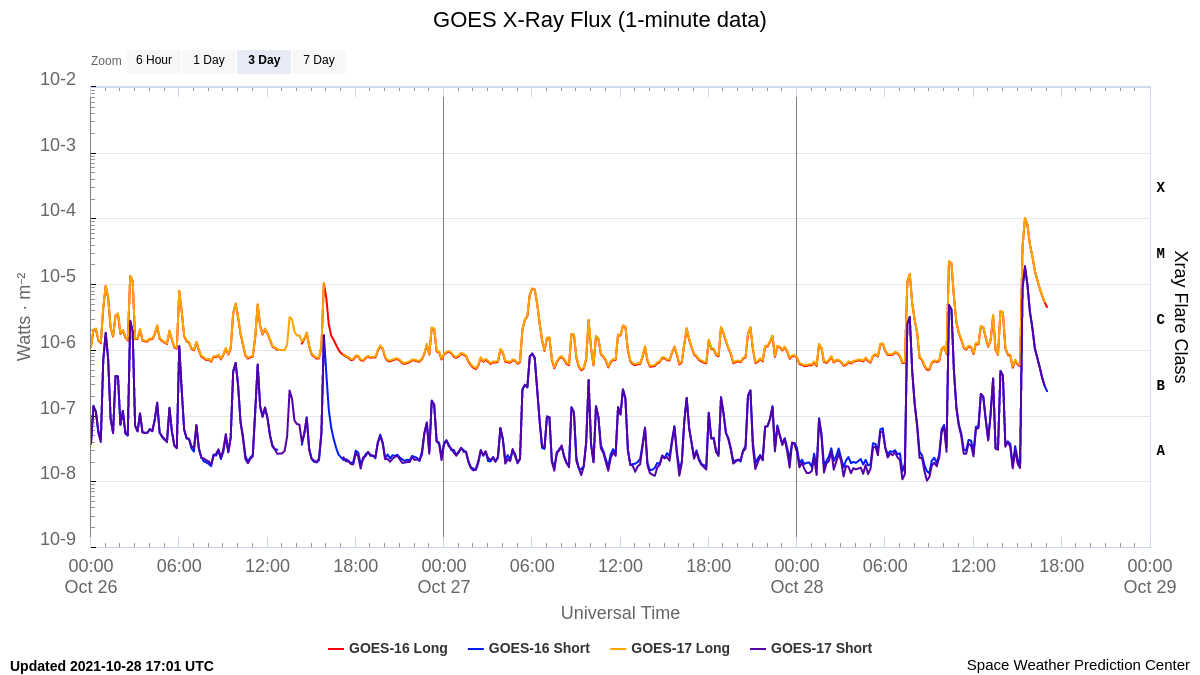
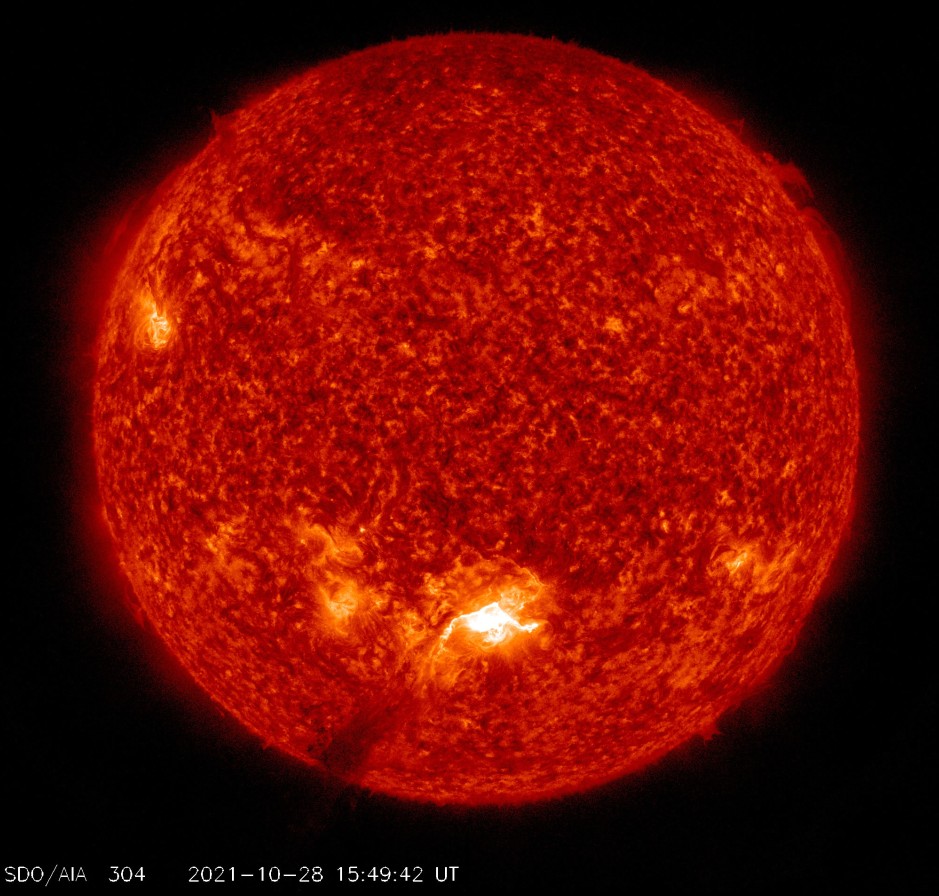
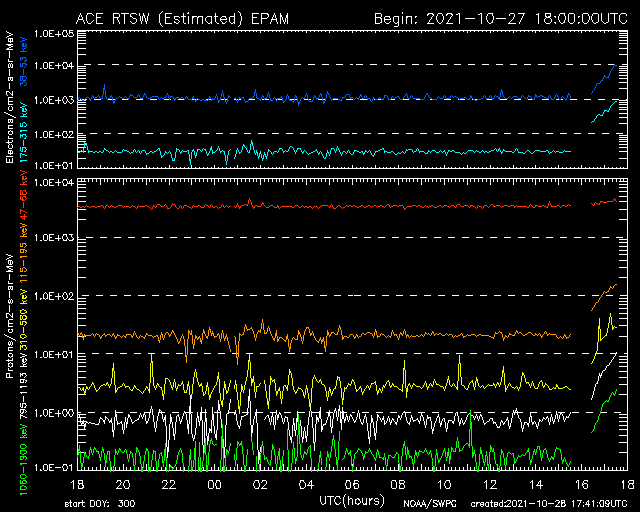

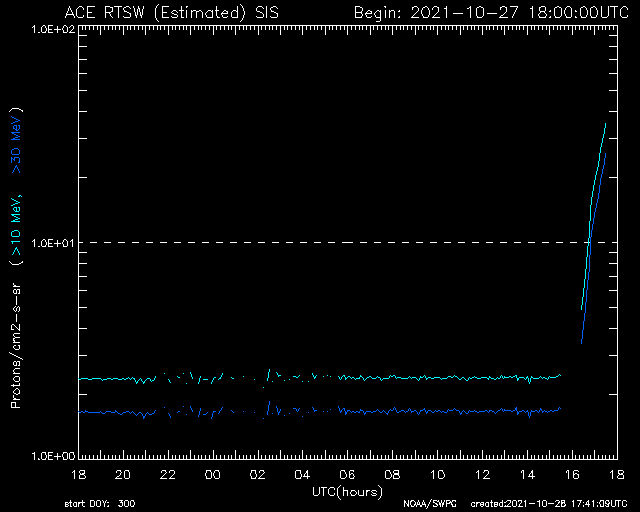

Space Weather Message Code: ALTPC0
Serial Number: 45
Issue Time: 2021 Oct 28 1651 UTC
ALERT: Proton Event 100MeV Integral Flux exceeded 1pfu
Begin Time: 2021 Oct 28 1635 UTC
www.swpc.noaa.gov/noaa-scales-explanation
Potential Impacts: An enhancement in the energetic portion of the solar radiation spectrum may indicate increased biological risk to astronauts or passengers and crew in high latitude, high altitude flights. Additionally, energetic particles may represent an increased risk to all satellite systems susceptible to single event effects. This information should be used in conjunction with the current Solar Radiation Storm conditions when assessing overall impact.
Space Weather Message Code: ALTTP4
Serial Number: 554
Issue Time: 2021 Oct 28 1557 UTC
ALERT: Type IV Radio Emission
Begin Time: 2021 Oct 28 1532 UTC
www.swpc.noaa.gov/noaa-scales-explanation
Description: Type IV emissions occur in association with major eruptions on the sun and are typically associated with strong coronal mass ejections and solar radiation storms.
Space Weather Message Code: SUMX01
Serial Number: 119
Issue Time: 2021 Oct 28 1555 UTC
SUMMARY: X-ray Event exceeded X1
Begin Time: 2021 Oct 28 1517 UTC
Maximum Time: 2021 Oct 28 1535 UTC
End Time: 2021 Oct 28 1548 UTC
X-ray Class: X1.0
Location: S26W04
NOAA Scale: R3 – Strong
www.swpc.noaa.gov/noaa-scales-explanation
Potential Impacts: Area of impact consists of large portions of the sunlit side of Earth, strongest at the sub-solar point.
Radio – Wide area blackout of HF (high frequency) radio communication for about an hour.
Space Weather Message Code: ALTTP2
Serial Number: 1104
Issue Time: 2021 Oct 28 1553 UTC
ALERT: Type II Radio Emission
Begin Time: 2021 Oct 28 1529 UTC
Estimated Velocity: 1263 km/s
www.swpc.noaa.gov/noaa-scales-explanation
Description: Type II emissions occur in association with eruptions on the sun and typically indicate a coronal mass ejection is associated with a flare event.
Space Weather Message Code: ALTXMF
Serial Number: 275
Issue Time: 2021 Oct 28 1536 UTC
ALERT: X-Ray Flux exceeded M5
Threshold Reached: 2021 Oct 28 1530 UTC
NOAA Scale: R2 – Moderate
www.swpc.noaa.gov/noaa-scales-explanation
Potential Impacts: Area of impact centered on sub-solar point on the sunlit side of Earth. Extent of blackout of HF (high frequency) radio communication dependent upon current X-ray Flux intensity. For real-time information on affected area and expected duration please see http://www.swpc.noaa.gov/products/d-region-absorption-predictions-d-rap.
Featured image: X1.0 solar flare October 28, 2021. Credit: NASA SDO/AIA 304, TW

@Anthony, the moon is EMPTY not full on Nov 4
I’m here to call in advance that I will laugh at all the magnetards when no major earthquake and increase in volcanic activity happens
There will be a major earthquake, most likely in San Andreas fault….
I agree that the sun’s behavior greatly affects the earth. A large earthquake may very well be in the offing. May see more volcanic activity, as we have since the sun became more active recently.
The sun farted in our general direction. The question is, how well will the Earth’s magnetic field handle the immense forces, when the magnetic north pole is nearly pointed at the Sun?
Strike while the iron is hot.Full moon also in Scorpio Nov 4th.Expect disruptions.
If Earth-directed CME will follow then watch for major earthquake and the increase in volcanic activity within the next 48-72 hours
I’m back. Where are the earthquakes and volcanic eruptions you promised?